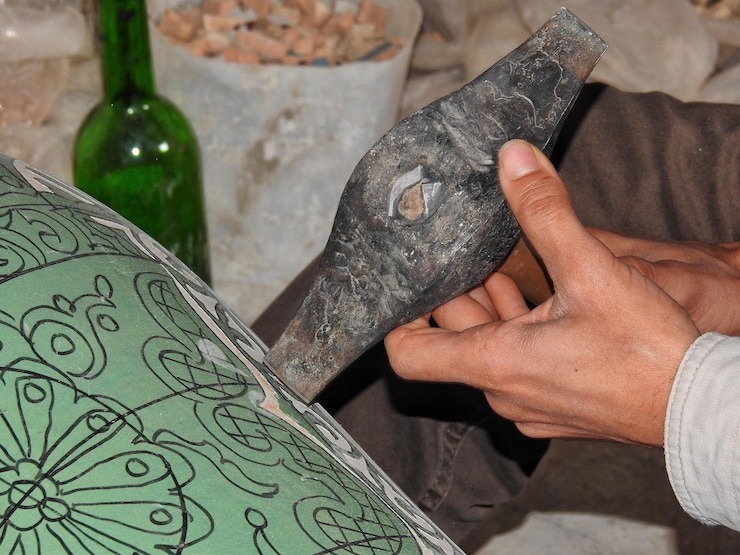


At Adhunik Block Print, we pour our heart into every piece, meticulously blending traditional techniques with contemporary designs. But have you ever wondered about the rich tapestry of history behind the art of block printing itself? It’s a journey that spans millennia, continents, and countless artistic innovations. Join us as we delve into the fascinating story of block printing, from its ancient origins to its vibrant resurgence in modern trends.
The roots of block printing stretch back further than many realize, making it one of the oldest forms of textile decoration and even early forms of mass communication. While its exact birthplace is debated, evidence points to its independent development in various parts of the world.
East Asia: The Cradle of Innovation: China is widely credited with the earliest sophisticated forms of block printing. Dating back to before 220 AD, early examples include silk fragments printed with intricate patterns. The perfection of papermaking in China provided an ideal canvas, leading to the widespread use of woodblock printing for Buddhist texts and images. The Diamond Sutra, printed in 868 AD, is considered the world’s earliest dated printed book, a testament to the advanced techniques of the Tang Dynasty. From China, the art form spread to Korea and Japan, where it flourished, giving rise to iconic art forms like Japanese Ukiyo-e prints.
India: A Kaleidoscope of Color: Simultaneously, or perhaps even earlier, block printing was developing in India, particularly in regions like Rajasthan, Gujarat, and Andhra Pradesh. Archaeological finds suggest its presence as far back as the Indus Valley Civilization. Indian block printing wasn’t primarily for texts but for adorning fabrics with vibrant dyes and intricate motifs. The readily available natural dyes from indigo, madder, turmeric, and pomegranate, combined with skilled craftsmanship, transformed simple cotton into stunning works of art. These textiles became highly sought after, influencing global trade routes.
Egypt and the Middle East: Evidence also suggests early forms of textile printing in ancient Egypt, though not always with carved blocks in the same way as in Asia. Later, during the Islamic Golden Age, intricate block-printed textiles were produced across the Middle East, often featuring geometric patterns and calligraphy.
As trade routes expanded, so too did the art of block printing.
The Silk Road’s Influence: The legendary Silk Road served as a conduit, carrying not just goods but also ideas and techniques. Indian textiles, renowned for their beauty and durability, were highly prized in Europe and the Middle East, sparking curiosity and demand for similar artistry.
Europe’s Embrace (and Adaptation): Block printing eventually reached Europe in the 12th and 13th centuries, initially for printing on linen and other fabrics. However, the development of the printing press by Gutenberg in the 15th century, while distinct, owes a debt to the principle of relief printing established by woodblock techniques. European block printing found its niche in wallpaper, playing cards, and later, for decorating chintz and other popular fabrics.
With the advent of industrialization and the invention of roller printing and screen printing in the 18th and 19th centuries, the manual art of block printing faced a significant decline. Factories could produce textiles faster and cheaper, pushing traditional artisans to the brink.
However, the late 19th and early 20th centuries saw a renewed appreciation for handcrafted items and artistic movements like the Arts and Crafts movement, which championed traditional skills and materials. This sparked a limited revival.
Today, block printing is experiencing a vibrant renaissance, appealing to a generation that values authenticity, sustainability, and unique artistic expression.
The Slow Fashion Movement: In an era of fast fashion, block printing stands as an antithesis. Each piece is a testament to human touch, patience, and skill. Consumers are increasingly seeking out clothing and home decor that tells a story, and block prints, with their inherent imperfections and unique character, perfectly fit this narrative.
Sustainable Practices: Many contemporary block printing businesses, like Adhunik Block Print, are committed to eco-friendly practices. This includes using natural dyes, organic fabrics, and minimizing waste, making block printing an attractive option for environmentally conscious consumers.
Global Fusion and Contemporary Design: While honoring traditional motifs and techniques, modern block printers are also experimenting with new designs, color palettes, and applications. We see fusion prints, abstract patterns, and a seamless blend of heritage and contemporary aesthetics. Block printing is no longer confined to traditional garments; it’s adorning modern apparel, accessories, home furnishings, and even art installations.
The Rise of Artisanal Brands: Small, independent businesses and artisan collectives are bringing block printing back into the mainstream, offering high-quality, limited-edition pieces that celebrate craftsmanship and cultural heritage.
At Adhunik Block Print, we are proud to be part of this rich legacy. We believe that by preserving and innovating upon this ancient art form, we are not just creating beautiful products, but also contributing to the continuation of a profound cultural heritage. Each time you choose a block-printed item, you are connecting with millennia of artistry, skill, and human creativity.
Explore our collection and discover how we’re keeping the spirit of block printing alive, one exquisite piece at a time.
Adhunik Block Print offers handcrafted textiles and apparel that blend timeless printing techniques with contemporary designs for a unique, sophisticated aesthetic.

Adhunik Block Print offers handcrafted textiles and apparel that blend timeless printing techniques with contemporary designs for a unique, sophisticated aesthetic.
Copyright © 2025 Adhunik Block Print. All Rights Reserved. | Created by MBG Card Pvt. Ltd.